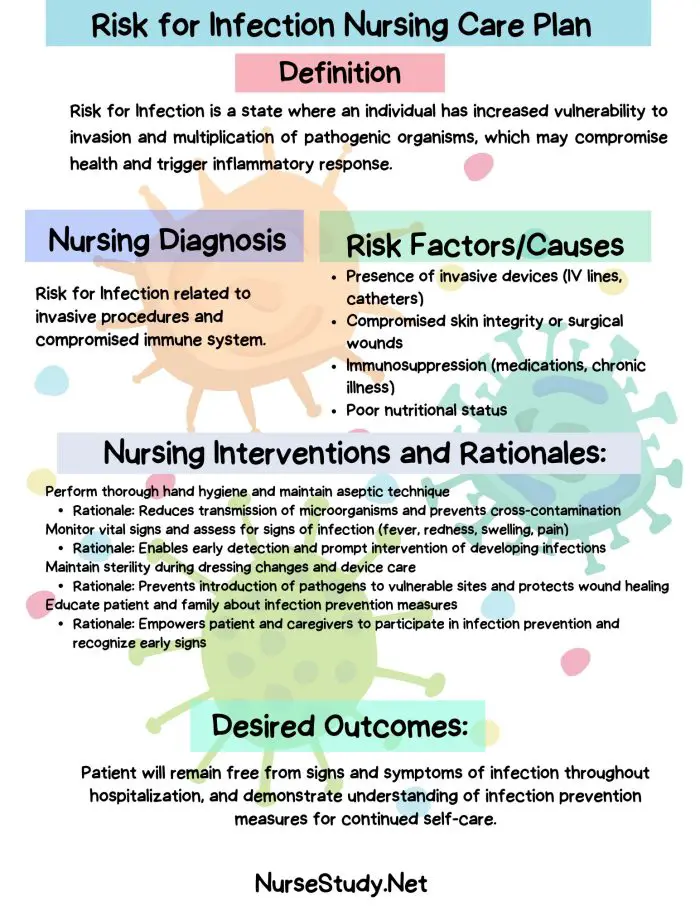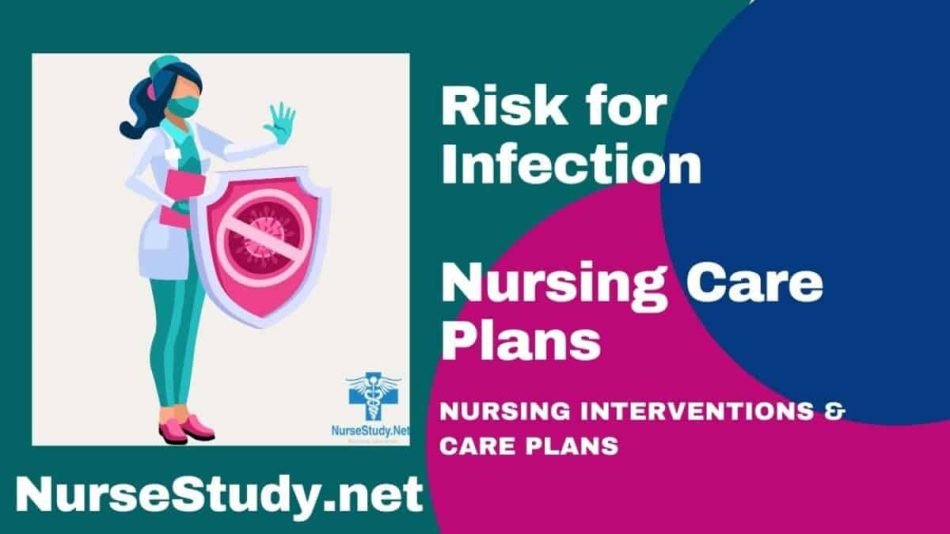Risk for Infection is a nursing diagnosis used when a patient is more likely to be invaded by pathogenic organisms.
This diagnosis is particularly important in healthcare settings where patients may have compromised immune systems or undergo procedures that increase their susceptibility to infections.
Risk Factors (Related to)
Several factors can contribute to a patient’s risk for infection:
- Compromised immune system (HIV/AIDS, cancer treatments, organ transplants)
- Chronic diseases (diabetes, renal failure)
- Invasive procedures (surgery, catheterization)
- Malnutrition
- Advanced age
- Prolonged hospitalization
- Breakdown of skin integrity (wounds, burns)
- Poor hygiene practices
- Exposure to environmental pathogens
- Use of immunosuppressive medications
Expected Outcomes
When addressing Risk for Infection, nurses aim to achieve the following outcomes:
- The patient remains free from signs and symptoms of infection
- Patient demonstrates understanding of infection prevention measures
- The patient maintains intact skin and mucous membranes
- Patient exhibits improved nutritional status to support immune function
- Patients and caregivers can identify early signs of infection
Nursing Assessment
A thorough nursing assessment is crucial for identifying and managing Risk for Infection. Here are key areas to focus on:
Physical Examination
- Assess skin integrity, looking for breaks, wounds, or rashes
- Check body temperature and other vital signs
- Examine all invasive device sites (IV lines, catheters)
Laboratory Data
- Monitor white blood cell count and differential
- Check for elevated C-reactive protein (CRP) or erythrocyte sedimentation rate (ESR)
Patient History
- Review medical history for chronic conditions or recent procedures
- Assess vaccination status
- Evaluate nutritional status and dietary intake
Environmental Factors
- Assess the hygiene practices of patients and caregivers
- Evaluate the cleanliness of the patient’s environment
Medication Review
- Identify any immunosuppressive medications
- Check for recent antibiotic use
Nursing Interventions
Effective nursing interventions are crucial for preventing infections in at-risk patients. Here are some key strategies:
Hand Hygiene
- Implement strict hand hygiene protocols for all healthcare providers, patients, and visitors.
- Educate patients and families on proper hand-washing techniques
Aseptic Technique
- Use sterile techniques for all invasive procedures
- Maintain sterility of medical devices and equipment
Environmental Control
- Ensure regular cleaning and disinfection of patient rooms and common areas
- Implement isolation precautions as needed
Patient Education
- Teach patients and families about infection prevention strategies
- Provide information on recognizing early signs of infection
Nutrition Support
- Encourage a balanced diet rich in nutrients that support immune function
- Consider nutritional supplements if needed
Wound Care
- Perform regular wound assessments and provide appropriate care
- Use sterile dressing changes and monitor for signs of infection
Immunization
- Ensure patients are up-to-date on vaccinations
- Administer vaccines as appropriate, following healthcare guidelines
Nursing Care Plans
Here are five detailed nursing care plans for Risk for Infection:
Care Plan 1: Compromised Immune System
Nursing Diagnosis Statement:
Risk for Infection related to compromised immune system secondary to chemotherapy treatment.
Related factors/causes:
- Decreased white blood cell count due to chemotherapy
- Increased vulnerability to opportunistic infections
- Potential for mucositis and skin breakdown
Nursing Interventions and Rationales:
- Monitor absolute neutrophil count (ANC) daily.
Rationale: ANC below 500 cells/mm³ significantly increases infection risk. - Implement neutropenic precautions when ANC is low.
Rationale: Minimizes exposure to potential pathogens. - Educate patients on hand hygiene and avoid crowds or sick individuals.
Rationale: Reduces risk of exposure to infectious agents. - Assess for signs of infection (fever, chills, new onset pain) every 4 hours.
Rationale: Early detection allows for prompt treatment. - Administer prophylactic antibiotics as prescribed.
Rationale: Helps prevent bacterial infections in high-risk patients.
Desired Outcomes:
- The patient will remain free from infection throughout chemotherapy treatment.
- The patient will demonstrate an understanding of neutropenic precautions and infection prevention strategies.
Care Plan 2: Invasive Devices
Nursing Diagnosis Statement:
Risk for Infection related to the presence of central venous catheter.
Related factors/causes:
- Break in skin integrity at the catheter insertion site
- Potential for microbial colonization of the catheter
- Frequent manipulation of the catheter for treatments
Nursing Interventions and Rationales:
- Perform thorough hand hygiene before any catheter manipulation.
Rationale: Reduces the risk of introducing pathogens to the catheter site. - Assess the catheter insertion site daily for signs of infection.
Rationale: Early detection of local infection can prevent systemic spread. - Use chlorhexidine-impregnated dressings for catheter site care.
Rationale: Chlorhexidine provides ongoing antimicrobial protection. - Change catheter dressings and caps according to facility protocol.
Rationale: Regular changes reduce the risk of bacterial colonization. - Educate the patient on signs of catheter-related infection to report.
Rationale: Patient awareness can lead to earlier detection and treatment.
Desired Outcomes:
- The catheter site will remain free from signs of infection.
- The patient will verbalize understanding of catheter care and infection prevention.
Care Plan 3: Impaired Skin Integrity
Nursing Diagnosis Statement:
Risk for Infection related to impaired skin integrity secondary to stage 2 pressure ulcer.
Related factors/causes:
- Open wound providing potential entry for pathogens
- Decreased tissue perfusion in the affected area
- Potential for bacterial colonization of the wound
Nursing Interventions and Rationales:
- Perform wound assessment and staging daily.
Rationale: Allows for early detection of wound deterioration or infection. - Clean the wound with the appropriate solution and apply the prescribed dressings.
Rationale: Maintains a clean wound bed and promotes healing. - Implement pressure redistribution strategies (turning schedules, specialized mattresses).
Rationale: Reduces further tissue damage and promotes wound healing. - Monitor nutritional status and encourage a high-protein diet.
Rationale: Adequate nutrition is essential for wound healing and infection resistance. - Educate patients and caregivers on proper wound care techniques.
Rationale: Ensures consistent and appropriate wound care between professional treatments.
Desired Outcomes:
- The wound will show progressive healing without signs of infection.
- Patients and caregivers will demonstrate proper wound care techniques.
Care Plan 4: Diabetes-Related Risk
Nursing Diagnosis Statement:
Risk for Infection related to poorly controlled diabetes mellitus.
Related factors/causes:
- Hyperglycemia leading to impaired immune function
- Potential for poor circulation, especially in extremities
- Increased risk of skin breakdown and slow wound healing
Nursing Interventions and Rationales:
- Monitor blood glucose levels regularly and administer insulin as prescribed.
Rationale: Maintaining glycemic control improves immune function and wound healing. - Perform daily foot assessments, looking for cuts, blisters, or signs of infection.
Rationale: Early detection of foot problems can prevent serious infections. - Teach proper foot care, including daily washing, thorough drying, and moisturizing.
Rationale: Good foot hygiene reduces the risk of skin breakdown and infection. - Encourage regular exercise as tolerated.
Rationale: Exercise improves circulation and helps maintain glycemic control. - Provide education on the importance of balanced nutrition and consistent carbohydrate intake.
Rationale: Proper nutrition supports immune function and helps manage blood glucose levels.
Desired Outcomes:
- The patient will maintain blood glucose levels within the target range.
- The patient will demonstrate an understanding of diabetic foot care and infection prevention.
Care Plan 5: Surgical Site Infection Risk
Nursing Diagnosis Statement:
Risk for Infection related to recent abdominal surgery.
Related factors/causes:
- Surgical incision providing potential entry for pathogens
- Decreased mobility in post-operative period
- Potential for poor wound healing due to various factors (e.g., age, nutrition, comorbidities)
Nursing Interventions and Rationales:
- Assess the surgical site every shift for signs of infection (redness, swelling, discharge, fever).
Rationale: Early detection of surgical site infection allows for prompt treatment. - Maintain sterile technique when changing surgical dressings.
Rationale: Reduces the risk of introducing pathogens to the wound. - Encourage deep breathing and coughing exercises.
Rationale: Promotes lung expansion and reduces the risk of respiratory infections. - Assist with early mobilization as tolerated.
Rationale: Improves circulation and reduces the risk of post-operative complications. - Administer prophylactic antibiotics as prescribed.
Rationale: Helps prevent surgical site infections in high-risk procedures.
Desired Outcomes:
- The surgical site will heal without signs of infection.
- The patient will demonstrate proper incision care techniques.
Conclusion
Risk for Infection is a critical nursing diagnosis that requires vigilant assessment and proactive interventions.
By understanding the risk factors, implementing appropriate nursing interventions, and following detailed care plans, healthcare providers can significantly reduce the incidence of infections in vulnerable patients.
Remember, prevention is always better than cure when it comes to infections.
References
- World Health Organization. (2021). Global report on infection prevention and control. WHO.
- Centers for Disease Control and Prevention. (2022). Guidelines for the Prevention of Intravascular Catheter-Related Infections. CDC.
- National Pressure Injury Advisory Panel. (2023). Prevention and Treatment of Pressure Ulcers/Injuries: Clinical Practice Guideline. NPIAP.
- American Diabetes Association. (2024). Standards of Medical Care in Diabetes. Diabetes Care.
- Berríos-Torres, S. I., Umscheid, C. A., Bratzler, D. W., et al. (2023). Centers for Disease Control and Prevention Guideline for the Prevention of Surgical Site Infection. JAMA Surgery.
- Loveday, H. P., Wilson, J. A., Pratt, R. J., et al. (2022). epic3: National Evidence-Based Guidelines for Preventing Healthcare-Associated Infections in NHS Hospitals in England. Journal of Hospital Infection.
- Ackley, B. J., Ladwig, G. B., Makic, M. B. F., Martinez-Kratz, M., & Zanotti, M. (2024). Nursing Diagnosis Handbook: An Evidence-Based Guide to Planning Care (13th ed.). Elsevier.
- Herdman, T. H., & Kamitsuru, S. (Eds.). (2023). NANDA International Nursing Diagnoses: Definitions and Classification 2024-2026. Thieme.
- Butcher, H. K., Bulechek, G. M., Dochterman, J. M., & Wagner, C. M. (2023). Nursing Interventions Classification (NIC) (8th ed.). Elsevier.
- Moorhead, S., Swanson, E., Johnson, M., & Maas, M. L. (2024). Nursing Outcomes Classification (NOC): Measurement of Health Outcomes (7th ed.). Elsevier.

